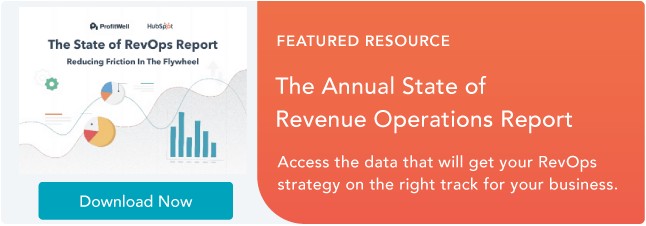As a marketer or business analyst, you know that data is an important part of your success. And the way you store and organize your data will either make your job easier or harder.
There are many ways that you can store data, one of them being data warehousing. This is an excellent option for businesses that need to look at a large amount of data from multiple sources. Today, let's learn what a data warehouse is and how it can help you analyze your data.
With a data warehouse, you can perform queries and look at historical data over time to improve decision-making. The main people in a company who will use data warehouses are data scientists and business analysts.
A data warehouse will get data from multiple sources, including relational databases or transactional systems. To access the data, analysts will use business intelligence tools to analyze, data mine, make visualizations, and conduct reporting. As data continues to evolve, it's imperative for businesses to use data to stay competitive.
What is the ultimate outcome of a data warehouse?
The ultimate outcome of a data warehouse is to extract insights, monitor performance, and improve decision-making. By using reports, dashboards, and visualizations, analysts have all the tools they need to make the right decisions.
Benefits of Using a Data Warehouse
1. Historical data.
One of the main benefits of data warehouses is the ability to look at a large amount of historical data over time. With a data warehouse, you can consolidate a large amount of data from many sources to better inform your business decisions. Looking at historical data will allow you to analyze trends over time and strategize effectively.
2. Data from multiple sources.
Additionally, with a data warehouse, you'll be getting data from multiple sources so you'll have a more complete picture when it comes time to analyze the information. With something like a data mart, you only get data from a single subject, as opposed to data warehouses that are meant to process and organize data from multiple sources.
3. Stability.
Data warehouses are also more stable sources of data that you can use to look at data at a high level or a granular level. This gives you the flexibility to look at data closely and perform queries quickly. A data warehouse will have high-quality data because it's coming from multiple sources, it's consistent and more accurate.
What Data Warehouses are Not
When you first hear the term "data warehouse," you might think of a few other data terms like "data lake," "database," or "data mart." However, those things are different because they have a more limited scope. While they might perform a similar function, the structure is different. Let's dive in below.
Data Lake vs. Data Warehouse
A data lake stores unfiltered data from multiple sources to be used for a specific purpose. This means that you're looking at raw data from something like social media or an app. The datasets are built at the time of analysis. This is low-cost storage for unformatted, unstructured data.
On the other hand, data warehouses are used to analyze and process data. In a data warehouse, the data has already been gathered and contextualized and is ready for analysis. Ultimately, it's a more advanced data storage tool that can use large amounts of historical data.
Data Mart vs. Data Warehouse
A data mart is a subset of a data warehouse. Usually, they're designed to easily deliver specific data to a specific user for a specific application. Data marts are single subject in nature, while data warehouses cover multiple subjects.
Database vs. Data Warehouse
Databases are often confused with data warehouses because they serve a similar purpose. However, the difference is that databases are not meant to perform analytics on a large collection of data. Databases are used to record and retrieve data while data warehouses are meant to analyze large amounts of data sets. Think about it like this: data warehouses store data from multiple databases.
Data Warehouse Architecture
A data warehouse architecture is a method you use to organize, communicate, and present your data.
You can use a basic architecture, a staging area, or a staging area and data marts.
This means that you can have a data warehouse get its data and then have the users look at reporting and analysis. Or you can have the data broken down into data marts before users look at the analysis and reporting.
The staging area you see in some of the images below is used to clean and process data before putting it in a warehouse. This simplifies data preparation. To get an idea of what each of these looks like, take a look at the images below.
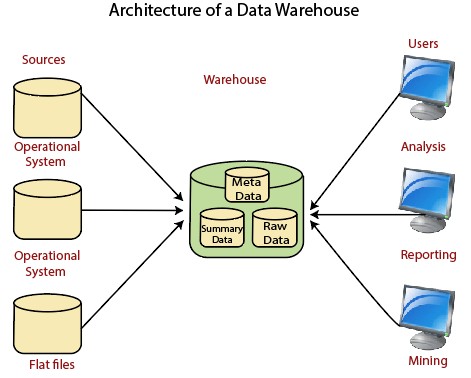
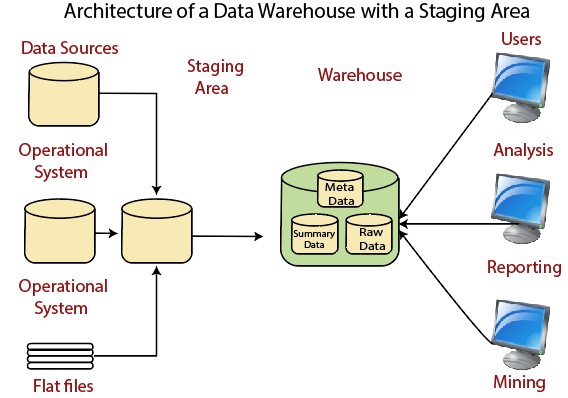
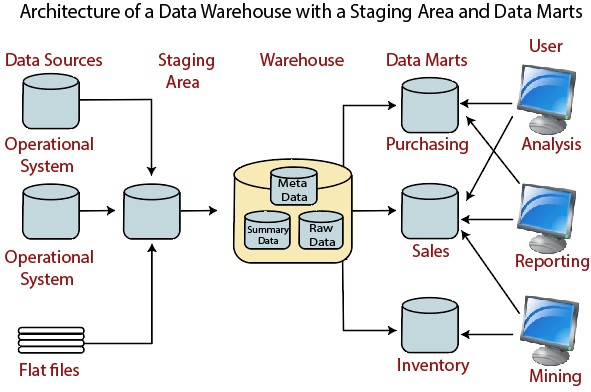
Data Warehouse Software
1. Snowflake Data Warehouse
Snowflake data warehouse is a data platform built on the cloud infrastructure. This is a great option for businesses that don't have the resources to support in-house servers.
With Snowflake, users can pay for storage and share data easily. You can mobilize data seamlessly across public clouds as data consumers, data providers, and data service providers. This software will help you democratize data analytics across your business so all users with varying expertise can make data-informed decisions.
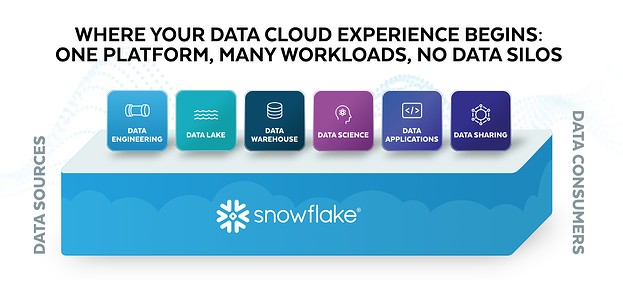
2. MarkLogic
With this data warehouse solution, you can perform complex search operations with different types of data including documents, relationships, and metadata. MarkLogic is a fully managed, fully automated cloud service to integrate data from silos.
3. Oracle
Oracle Autonomous Data Warehouse is a fully managed database tuned and optimized for data warehouse workloads with the performance of Oracle Database. It delivers a new, comprehensive cloud experience for data warehousing that is easy, fast, and elastic.
While data solutions might seem overwhelming, they're important for your day-to-day business decisions. With a data warehouse, you can simplify your data storage, management, and analytics.

